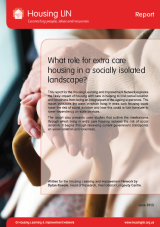What role for extra care housing in a socially isolated landscape?

This Housing LIN report highlights five core elements of extra care housing that give older people fulfilling, socially-connected lives. They are:
- The ethos of extra care housing promotes the concept of a home (and community) for life, independence, homeliness and flexible care pathways.
- The design of extra care housing schemes promotes social contact through 'building in' communal areas and facilities - such as cafes and leisure facilities - that encourage residents to mix. Sometimes these facilities are also open to the wider community.
- Residents of extra care schemes can also participate (or not) in a wide range of activities both onsite and in the wider community. These range from onsite exercise classes through to joining local organisations outside the housing development. Although many residents, particularly the younger and fitter ones, will take part in a range of 'mainstream' activities off-site, the less active ones can still gain the social contact offered by even relatively low-key activities within the housing scheme - such as exercise classes or quizzes.
- With care and support staff available on-site around the clock, new residents have access to some social interaction from the off. Most studies of social wellbeing in extra care note the importance of staff in supporting new residents as they develop and strengthen social relationships. We see this as an in-built sense of community and the fourth building block of social interaction in extra care.
- And finally, there is evidence that extra care housing offers improved health and functional ability with, for example, fewer falls and shorter hospital stays. Residents feel more confident about - and are more capable of - engaging in social activities.
